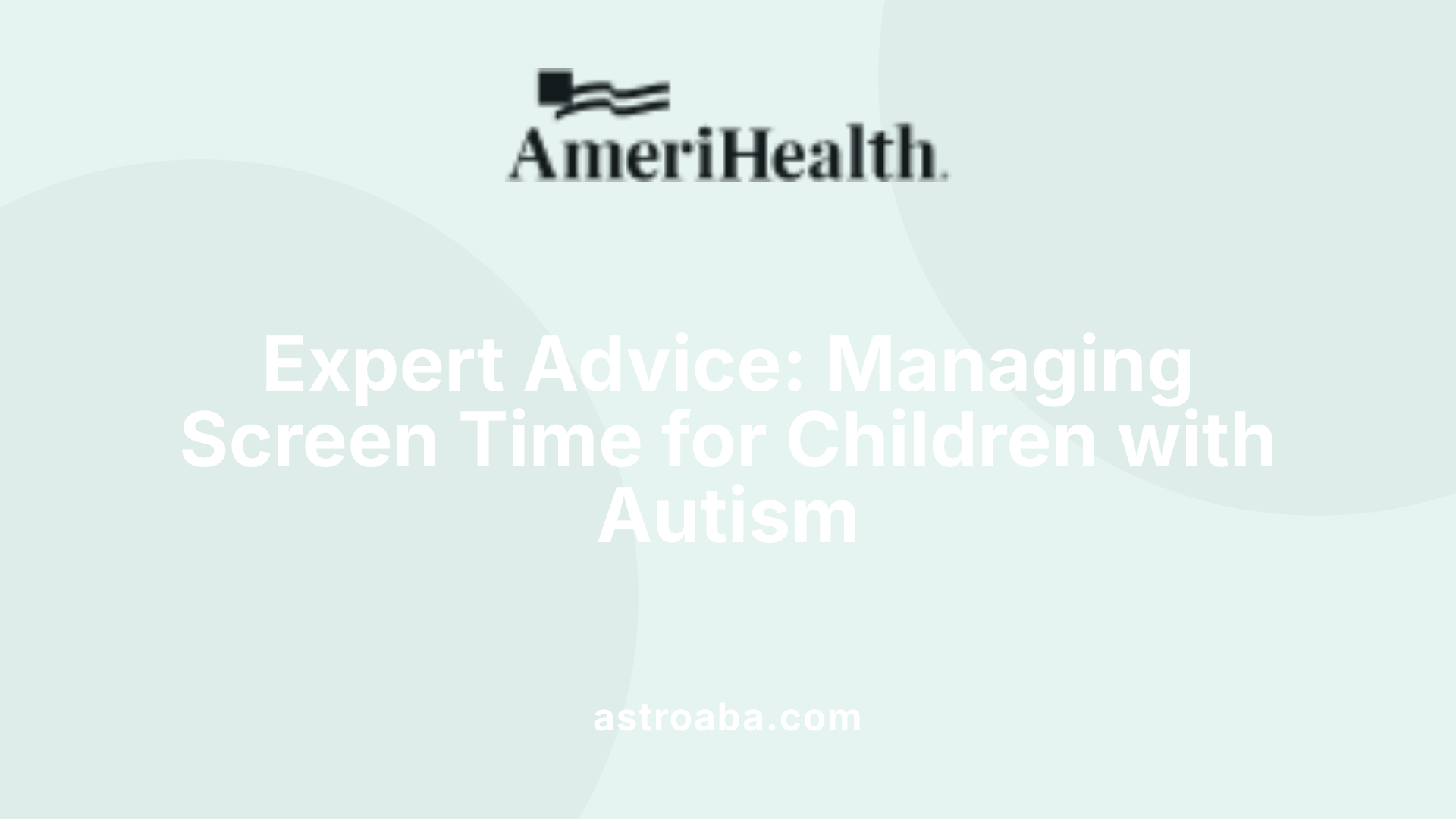Screen Time and Autism
Understanding the Complex Relationship Between Screen Time and Autism Spectrum Disorder

Exploring the Contemporary Evidence and Practical Implications
As digital media becomes increasingly pervasive in children's lives, understanding the implications of screen time on neurodevelopmental conditions such as autism spectrum disorder (ASD) has garnered significant attention from researchers, clinicians, and parents. While autism is fundamentally a neurodevelopmental disorder driven by genetic and biological factors, emerging evidence suggests that early and excessive exposure to screens may influence the development and severity of ASD symptoms. This article synthesizes the latest scientific research, reviews, and expert insights to provide a comprehensive overview of how screen time may be linked to autism, its potential developmental impacts, and strategies for managing media use effectively.
Correlation Between Screen Time and Autism Symptoms
Does increased screen time correlate with autism spectrum disorder symptoms?
Based on current research, there is a notable association between high levels of screen time in early childhood and the presence of autism spectrum disorder (ASD) symptoms. Studies consistently show that children exposed to screens for extended periods tend to display behaviors characteristic of autism, including delayed speech, hyperactivity, and difficulties with social interaction.
Early exposure to screens—particularly during the first year of life—has been linked with a greater likelihood of developing ASD. For instance, data from the Longitudinal Study of Australian Children demonstrated that children who engaged in more screen time by age 2 showed a higher chance of an ASD diagnosis by age 12. Although these studies reveal a correlation, they do not necessarily confirm causation. The complex nature of neurodevelopment means other factors, such as socioeconomic status and genetic predispositions, also play roles.
Excessive screen use can interfere with activities vital for brain development, including talking, playing, singing, and reading. Children with autism often spend more time looking at screens, which might reflect their social difficulties rather than causing them. Furthermore, interventions that reduce screen exposure have been associated with improvements in social and communication skills among children with ASD.
Some case reports reinforce these findings. For example, children with autism who decreased their screen time showed notable progress in language and social behaviors, while increasing screen time often led to behavioral regressions.
While the evidence highlights a connection between screen time and autism-like symptoms, interpretations should be cautious. Most current studies use screening tools like the MCHAT, which identify risk markers rather than definitive diagnoses. Still, the consensus emphasizes limiting media exposure during early childhood.
The American Academy of Pediatrics recommends no screen time for children under 18-24 months and no more than one hour daily for preschoolers, to support healthy development. Avoiding excessive media and focusing on human interaction, play, and exploration remain essential for optimal neurodevelopment.
In summary, although a direct cause-and-effect relationship between screen time and autism has not been established, evidence suggests that excessive media use during early childhood is linked with increased autism symptoms and developmental challenges. Moderation, along with promoting offline activities, is crucial for healthy growth.
Impact of Early Exposure and Critical Development Periods

Timing of screen exposure
Research suggests that the age at which children are exposed to screens plays a significant role in potential developmental impacts. Early childhood, especially during the first year of life, appears to be a critical window. During this period, the brain is rapidly developing, and young children lack the cognitive skills to learn from screens effectively. Excessive exposure during this time can interfere with vital activities such as talking, playing, singing, and reading, all of which are essential for healthy brain development.
First year of life
Studies indicate a notable correlation between screen time in infants and a higher likelihood of developing Autism Spectrum Disorder (ASD). For example, one study in Japan found that screen use at age 1 predicted parent-reported autism diagnosis at age 3. Moreover, subtle differences in infants with autism are sometimes already observable at age 1, which can influence media habits later. This emphasizes the importance of limiting screen exposure during this sensitive developmental window.
Developmental windows
Certain periods in early childhood are considered especially crucial for social, emotional, and language development. Excessive screen time during preschool years—when children are typically acquiring fundamental social and communication skills—has been associated with an increase in autism-like behaviors. Longer durations of daily screen exposure, particularly four hours or more, are linked with more severe autism symptoms.
While the evidence does not conclusively establish that screen use directly causes autism, a consistent pattern shows that higher screen time correlates with increased autism symptoms and diagnosis. Limiting screen use, especially during these critical early years, can support healthier development.
| Age/Period | Screen Time Impact | Developmental Concerns | Recommendations |
|---|---|---|---|
| First Year of Life | Significant link | Greater risk of ASD, subtle early differences | Avoid excessive screen exposure |
| Preschool Years | Higher hours linked | Autism-like behaviors, delays in social/emotional skills | Limit to less than 1 hour/day, focus on activities like play, reading |
Screen Media Effects on Children with Autism
Potential Developmental Risks and Benefits of Screen Media

Are there potential developmental impacts or risks of screen media on children with autism?
Research indicates that early and excessive screen media exposure can influence development in children, including those with autism spectrum disorder (ASD). Studies highlight that children with ASD who watch screens for more than four hours daily tend to exhibit more severe symptoms, and ongoing exposure during critical developmental stages may contribute to difficulties in social communication and language skills.
Some evidence suggests that reducing screen time and increasing opportunities for social interactions can lead to improvements in language, social responsiveness, and overall behavior. Case reports specifically point out that children with autism who cut back on screen use often show progress in speech and social skills, with setbacks occurring when screen time increases.
Despite these findings, current scientific literature does not confirm a direct causal link between screen media and the development of autism itself. Instead, most studies observe associations, and some, after controlling for confounding factors, find that the relationship may not be causative. This means that children with existing neurodevelopmental differences might use screens differently, perhaps as a way to cope or connect.
Screens can also offer benefits for children with autism, such as facilitating social connection, helping with communication, and providing a predictable environment for learning. These digital tools can promote access to education and support skills development when integrated thoughtfully.
In summary, while excessive and early exposure to screens may pose some developmental risks, especially regarding social and language skills, purposeful and moderated use of technology combined with social and therapeutic activities can potentially mitigate these risks and support positive developmental trajectories.
Expert Strategies and Intervention Approaches

What intervention strategies or expert insights exist regarding screen use and autism?
Experts recommend setting personalized guidelines for managing screen time among children with autism, considering their developmental stage, specific needs, and family routines. Research indicates that excessive screen exposure, especially during early childhood, may be linked to increased autism symptoms and developmental delays. Therefore, moderation and careful content selection are advised.
One effective approach involves parental involvement. Training programs aimed at reducing overuse encourage parents to monitor and regulate their child's media habits actively. These programs can help caregivers implement consistent rules, promote offline social interactions, and choose appropriate educational content.
Tools like Video Modeling and Picture Exchange Communication System (PECS) serve as therapeutic frameworks to substitute or supplement screen time with meaningful social and communication activities. These tools can enhance social skills and reduce reliance on screens.
Monitoring behaviors that suggest overexposure—such as decreased eye contact, repetitive actions, or withdrawal—is crucial. Addressing these early signs by adjusting media consumption can mitigate potential impacts.
Furthermore, digital media can be harnessed constructively. For example, apps designed for social skill training or emotion recognition can support therapy goals when used judiciously. Encouraging digital activities that foster interaction, learning, and self-regulation helps balance screen time with vital offline experiences.
Overall, collaborative efforts involving parents, therapists, and educators are essential. Tailoring strategies to each child's needs, alongside ongoing assessment, ensures that screen use remains a beneficial part of development rather than a hindrance.
| Strategy | Implementation Example | Purpose & Benefit |
|---|---|---|
| Setting limits | Limiting screen time to age-appropriate durations (e.g., under 1 hour for preschoolers) | Reduces risk of developmental interference |
| Content supervision | Choosing educational and calming media rather than entertainment or fast-paced content | Enhances learning while minimizing overstimulation |
| Parent training | Engaging in programs that teach media management and social engagement strategies | Empowers caregivers to support developmental goals |
| Use of therapeutic tools | Incorporating apps that promote social-emotional skills or alternative communication methods | Supports skill development alongside media use |
| Regular assessment | Observing behavioral markers indicating overuse and adjusting accordingly | Ensures linked behaviors are addressed proactively |
In summary, expert insights emphasize a balanced, individualized approach to screen use, integrating technology support with traditional therapeutic and social activities. These strategies aim to foster healthy development while leveraging digital media's benefits for children with autism.
Causality and Media's Role in Autism Development

Is there evidence that screen time contributes to autism or autism-like symptoms?
Current research indicates that there is no clear proof that screen time directly causes autism spectrum disorder (ASD). However, several studies have found noteworthy associations between early childhood screen exposure and the emergence of autism-like behaviors.
Many studies point out that children exposed to screens during their first year of life tend to show more signs related to ASD later on. These signs include language delays, reduced social engagement, and increased repetitive behaviors. It’s important to note that most studies used screening tools like the MCHAT, which identify children at risk for autism but do not confirm a diagnosis. This means that while increased screen time correlates with autism symptoms, it does not necessarily cause autism.
Some evidence suggests that excessive media use during early development might influence brain organization. For example, children with high screen exposure often exhibit delays in speech, attention issues, and hyperactivity. These developmental challenges could be linked to reduced opportunities for meaningful face-to-face interactions, play, and activities that promote cognitive growth.
However, it is crucial to recognize that autism is mainly considered a neurodevelopmental disorder driven by genetic factors. Studies controlling for socioeconomic influences and other variables have shown that the relationship between screen time and autism is complex and not conclusively causal.
Research including large datasets, such as the Longitudinal Study of Australian Children, indicates that while early screen use is associated with higher odds of ASD, this association weakens when considering socioeconomic and environmental factors. This suggests that children with certain genetic predispositions may be more vulnerable to the effects of early media overexposure.
Overall, reducing excessive screen time in infancy and fostering active social interactions are recommended to support healthy development. These strategies may help mitigate some potential risks associated with media use, even if a direct cause-and-effect link between screen time and autism remains unproven.
| Aspect | Findings | Additional Details |
|---|---|---|
| Early exposure risk | Linked to increased autism-like symptoms in some studies | Particularly within the first year of life |
| Brain development | Limited evidence of brain differences linked to media use but plasticity exists | One study showed less organized brain matter with unhealthy screen habits |
| Observational evidence | Many studies observe associations but do not establish causation | Use of screening tools vs. diagnostic confirmation |
| Genetic factors | Autism largely driven by genetics, not media exposure | Environmental factors may influence expression of autism traits |
| Practical advice | Limit screen time, especially in infants; promote social play | American Academy of Pediatrics recommends minimal screen exposure for under 2 years |
| Effective interventions | Reducing screen time can improve symptoms in children with ASD | Parent training programs supporting social engagement are beneficial |
In conclusion, while early screen exposure correlates with autism-related symptoms, it is not considered a causative factor. Instead, media use should be balanced with activities promoting social and cognitive skills, especially during critical early developmental periods.
Reflecting on the Neuroplasticity and Screen Use Balance

What do current studies say about screen time and neurodevelopmental conditions like ADHD and possible autism-like symptoms?
Recent research suggests that increased screen time during early childhood is linked to a higher chance of developing autism spectrum disorder (ASD) symptoms and behaviors similar to ADHD. Studies reveal that children exposed to screens earlier and for longer durations often show more developmental concerns, such as social communication challenges, delayed language, and repetitive behaviors.
A comprehensive systematic review and meta-analysis examined multiple studies and found a small but notable association between screen exposure and ASD. However, after adjusting for publication bias, this link was less statistically significant. Importantly, this research indicates correlation, not direct causation; autism is still primarily understood as a neurodevelopmental condition with strong genetic components.
Despite these concerns, screens can sometimes serve as helpful tools for children with neurodivergent needs, supporting communication, social engagement, and learning. Yet, excessive or inappropriate use can worsen attention span issues and sleep patterns.
Brain plasticity—the brain’s ability to change and reorganize itself—offers reassurance. Small habit modifications, such as reducing screen time and increasing offline, interactive activities, can lead to positive changes in brain structure and function. These adjustments help support healthy neurodevelopment and skill acquisition.
Implementing balanced routines that limit screen time while promoting real-world activities like playing, talking, reading, and social interaction is essential. These strategies foster brain resilience, enhance communication skills, and encourage emotional growth. Neuroplasticity underscores the importance of engaging the brain through diverse experiences, giving children the best foundation for healthy development.
Informed Choices for Healthy Development
While the relationship between screen time and autism remains complex and not fully causative, current research emphasizes moderation and mindful engagement. Limiting early media exposure, particularly during critical developmental periods, can support better social, language, and emotional growth. For children with autism, carefully curated screen use can complement therapeutic strategies and enhance learning, provided it is balanced with real-world interaction, play, and face-to-face communication. Parent education, individualized guidelines, and ongoing research are essential in navigating the digital age's challenges and opportunities. Ultimately, fostering environments that prioritize social connection and developmental activities will aid children’s lifelong wellbeing and resilience.
References
- Early Screen-Time Exposure and Its Association With Risk of ...
- Early Childhood Screen Time, Brain Development, and Autism - AAP
- Screen Time Before 2 Years of Age and Risk of Autism at 12 Years ...
- Screen Time and Social Engagement in Early Childhood Development
- Autism and screen time: Are they related? - Norton Children's
- Neurodivergent Kids and Screen Time - Child Mind Institute
- Screen Time and Autism Spectrum Disorder: A Systematic Review ...
Recent articles

The Role of Prompting and Fading in ABA Therapy Programs
Enhancing Autism Interventions Through Systematic Support Reduction

The Role of ABA Therapy in Supporting Community Participation
Enhancing Lives Through Community-Focused ABA Interventions

The Role of ABA Therapy in Encouraging Initiative and Motivation
Unlocking Potential: How ABA Empowers Children to Take Initiative

How ABA Therapy Helps Children Develop Initiation and Motivation
Unlocking Potential: The Power of ABA in Fostering Child Independence

How ABA Therapy Encourages Participation in Cooperative Group Activities
Fostering Social Skills Through ABA Interventions

How ABA Therapy Supports Independent Task Initiation in Children
Empowering Children to Begin with Confidence

How ABA Therapy Helps Children Build Resilience in Challenging Situations
Building Emotional Strength Through ABA Therapy

The Impact of ABA Therapy on Reducing Anxiety in Social Settings
Transforming Social Experiences: How ABA Therapy Eases Autism-Related Anxiety

Strategies for Teaching Self-Monitoring Through ABA
Empowering Independence: Techniques to Foster Self-Monitoring with ABA

The Benefits of Combining ABA with Speech and Language Therapy
Integrating Treatment Approaches to Maximize Developmental Progress

Strategies for Teaching Cooperative Problem-Solving Through ABA
Enhancing Collaborative Skills with ABA: Proven Strategies and Techniques

How ABA Therapy Encourages Independent Participation in Daily Tasks
Empowering Autonomy: How ABA Therapy Builds Independence in Daily Life

Creating an Effective Learning Environment at Home for ABA Therapy
Building a Supportive Home Environment for ABA Success

How ABA Therapy Encourages Following Safety Rules at Home and School
Empowering Children with Autism to Follow Essential Safety Rules

How ABA Therapy Encourages Communication Using Gestures and Signs
Enhancing Social Skills with Targeted Gesture Teaching

Common ABA Therapy Techniques for Reducing Aggression
Innovative Strategies in ABA to Minimize Aggressive Behaviors

How ABA Therapy Encourages Communication Using Gestures and Signs
Unlocking the Power of Gestures and Signs in Autism Therapy

How ABA Therapy Encourages Appropriate Social Greetings
Enhancing Social Skills Through Evidence-Based Interventions

Addressing Social Anxiety Using ABA-Based Techniques
Harnessing ABA to Alleviate Social Anxiety

Famous Politicians With Autism
Celebrating Neurodiversity: Insights into Autism and Notable Figures

How ABA Therapy Can Help with Anxiety in Children with Autism
Unlocking Emotional Well-Being: The Power of ABA in Managing Autism-Related Anxiety

The Impact of ABA Therapy on School Success
Enhancing Educational Outcomes with Systematic Interventions

The Importance of Social Stories in ABA Therapy
Harnessing Social Stories to Enhance Social Skills in Autism Interventions

Mild Autism
Understanding the Nuances of Mild Autism

What Are Functional Behavior Assessments (FBA) in ABA Therapy?
Unlocking the Secrets Behind Behavior: The Power of FBAs in ABA

Early Signs Of Autism In Babies And Kids
Recognizing Early Indicators to Support Developmental Health

How to Find Funding for ABA Therapy Services
Unlocking Funding Opportunities for Autism Treatments

How to Help a Child with Autism Transition to ABA Therapy
Supporting Children Through Transition Phases in ABA Therapy

Do Autistic People Get Injured More?
Examining Injury Risks in Individuals with Autism Spectrum Disorder

How ABA Therapy Can Help with Executive Functioning Challenges
Unlocking Skills: The Impact of ABA on Executive Functioning in Autism

What is the Premack Principle in ABA Therapy?
Unlocking Motivation: The Power of the Premack Principle in ABA Therapy

Low-Functioning Autism
Understanding the Challenges and Supports for Low-Functioning Autism

Low-Functioning Autism
Understanding the Challenges and Supports for Low-Functioning Autism

How ABA Therapy Can Help with Playdates and Social Events
Unlocking Social Success: How ABA Therapy Facilitates Playdates and Community Engagement

How ABA Therapy Can Address Impulse Control Issues
Mastering Behavioral Growth: The Power of ABA in Impulse Control

Book, Movie, and TV Characters on the Autism Spectrum
Enhancing Understanding Through Fictional Portrayals

Book, Movie, and TV Characters on the Autism Spectrum
Enhancing Understanding Through Fictional Portrayals

The Role of Visual Supports in ABA Therapy
Enhancing Autism Interventions with Visual Supports

What Is Pervasive Developmental Disorder
Understanding the Spectrum of Developmental Challenges

How ABA Therapy Helps with Emotional Regulation
Empowering Emotional Resilience in Children with Autism

What is Task Analysis in ABA Therapy?
Unveiling the Foundations of Task Analysis in ABA Therapy

How ABA Therapy Can Improve Play Skills
Unlocking Growth: The Power of ABA in Enhancing Play Skills

Air Pollution and Autism
Unveiling the Environmental Impact on Developing Minds

How ABA Therapy Can Help with Bullying Prevention
Building Respect and Resilience Through ABA

How ABA Therapy Can Be Used to Teach Problem-Solving Strategies
Empowering Individuals with Autism Through Targeted Problem-Solving Skills

Can Autistic People Work?
Unlocking Potential: The Realities of Employment for Autistic Individuals

How ABA Therapy Can Help with Homework and Academics
Empowering Academic Success with ABA Therapy

Common Myths About ABA Therapy Debunked
Unmasking Autism Treatment: The Truth About ABA Therapy

Does Aluminum Cause Autism?
Unraveling the Link: Aluminum and Autism Spectrum Disorder

How ABA Therapy Can Support Emotional Expression and Understanding
Unlocking Emotional Growth in Autism Through ABA Therapy

The Role of ABA Therapy in Helping Children Learn Road Safety
Empowering Safe Journeys: How ABA Therapy Fosters Road Safety Skills in Children

The Role of Group ABA Therapy in Social Development
Enhancing Social Skills Through Collective Strategies

What Is Autistic Burnout?
Understanding the Hidden Struggle of Autistic Burnout

How Do You Get An Autistic Child To Keep Their Shoes On?
Mastering Comfort and Compliance with Shoes for Autistic Children

The Role of ABA Therapy in Addressing Food Aversions and Picky Eating
Transforming Mealtimes: How ABA Therapy Supports Children with Autism

How ABA Therapy Can Assist in Reducing Perfectionism and Anxiety
Harnessing Behavioral Science to Ease Perfectionism and Anxiety

What Is Defeat Autism Now?
Unveiling the Roots and Realities of the DAN Movement

How ABA Therapy Can Help Children Develop Conflict Resolution Skills
Building Bridges: Empowering Children with Conflict Resolution Skills through ABA

OCD vs. Autism
Unraveling the Complex Relationship Between OCD and Autism

Temper Tantrums A Sign Of Autism
Understanding the Complex Relationship Between Temper Tantrums and Autism Spectrum Disorder

How to Pass the BCBA Exam
Your Ultimate Guide to Success in the BCBA Exam

Autism and Addiction's Close Connection
Unraveling the Complex Interplay Between Autism and Substance Use

Autism Facial Expressions
Decoding Emotions: The Complex World of Facial Expressions in Autism

How ABA Therapy Can Help Reduce Anxiety Around Doctor and Dentist Visits
Transforming Medical Experiences for Children with Autism

How ABA Therapy Can Help with Navigating Social Media Responsibly
Empowering Safe Online Engagement for Children with Autism through ABA

How to Choose an Autism Charity
Navigating the Spectrum of Support: A Guide to Selecting the Right Autism Charity

What is Precision Teaching in ABA Therapy?
Harnessing Data-Driven Strategies for Skill Mastery

Autism and Obesity
Understanding the Overlap: Autism and the Rising Concern of Obesity

Individualized Education Programs (IEPs) for Autism
Supporting Success: A Comprehensive Guide to IEPs for Children with Autism

How to Integrate ABA Therapy into Everyday Routines
Transforming Daily Life with ABA Strategies

What is Shaping in ABA Therapy?
Understanding the Core of Behavior Shaping in Autism Interventions

Autism vs. ADHD
Understanding the Distinction and Overlap of Neurodevelopmental Disorders

Is RBT Certification Worth It?
Unveiling the Value of RBT Certification in the Field of ABA

How Negative Reinforcement Works in ABA Therapy
Unlocking the Power of Negative Reinforcement in Behavioral Therapy

How to Advocate for ABA Therapy Services in Schools
Navigating Advocacy for School-Based ABA Therapy

How ABA Therapy Can Address Impulsivity in Children
Transforming Child Behavior: The Power of ABA Therapy Against Impulsivity

Understanding the Different Types of ABA Therapy Programs
Exploring the Spectrum of ABA Therapy Approaches

How ABA Therapy Can Address Regression in Autism
Understanding Regressive Autism and the Role of ABA Therapy

High Functioning Autism And Anger
Understanding Emotional Challenges in High-Functioning Autism

Autism and Puberty
Understanding Puberty in Autistic Youth: Challenges and Support Strategies

Challenging Autism Behavior Problems
Navigating the Complex Landscape of Autism-Related Behavioral Challenges

How ABA Therapy Can Help with Sleep Problems
Transforming Bedtime Routines with Evidence-Based Approaches

How ABA Therapy Can Help Improve Cooperation and Compliance
Fostering Respectful Engagement: The Role of ABA in Enhancing Cooperation and Compliance

Eating Disorders And Autism
Unraveling the Complex Relationship Between Autism and Eating Disorders

How Schedules of Reinforcement Work in ABA Therapy
Mastering Reinforcement Patterns to Foster Behavior Change

How to Incorporate ABA Therapy into a Homeschooling Program
Transforming Homeschooling with Evidence-Based Strategies

What Are the Most Common Misconceptions About ABA Therapy?
Unveiling the Truth Behind ABA Therapy: Myths vs. Facts

What is Demand Fading in ABA Therapy?
Demystifying Demand Fading in ABA Therapy

What Are ABA Assessments and How Do They Work?
Understanding the Foundations of ABA Assessments

What is an AAC Device for Autism?
Unlocking Communication: The Power of AAC Devices for Autism

How ABA Therapy Can Help Children Understand and Express Emotions
Enhancing Emotional Understanding Through Evidence-Based Interventions

How To Prevent Autism
Emerging Strategies to Reduce Autism Risk in Children

How ABA Therapy Can Improve Verbal and Nonverbal Communication
Unlocking Communication: The Power of ABA Therapy for Children with Autism

Natural Environment Teaching (NET): How It Helps with Skill Generalization
Unlocking Practical Learning in Natural Settings

What Is Play Therapy For Autism?
Unlocking the Potential of Play in Autism Therapy

How ABA Therapy Can Improve Fine and Gross Motor Skills
Enhancing Movement and Independence Through ABA Strategies

Calming Strategies For Kids With Autism
Understanding and Supporting Calmness in Children with Autism

Autism Evaluation
Comprehensive Insights into Autism Assessment and Diagnosis

How to Support Your Child's ABA Therapy at Home
Empowering Your Child’s Development at Home with ABA Support

Autism Prevalence Increases in Arizona
Rising Autism Rates Signal Changing Landscape in Arizona

